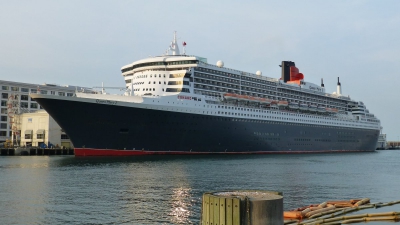RMS Queen Elizabeth was an ocean liner operated by Cunard Line. With Queen Mary she provided weekly luxury liner service between Southampton in the United Kingdom and New York City in the United States, via Cherbourg in France.
While being constructed in the mid-1930s by John Brown and Company at Clydebank, Scotland, the build was known as Hull 552. She was launched on 27 September 1938 and named in honour of Queen Elizabeth, who was later known as the Queen Mother. With a design that improved upon that of Queen Mary, Queen Elizabeth was a slightly larger ship, the largest passenger liner ever built at that time and for 56 years thereafter. She also has the distinction of being the largest-ever riveted ship by gross tonnage. She first entered service in February 1940 as a troopship in the Second World War, and it was not until October 1946 that she served in her intended role as an ocean liner.
With the decline in popularity of the transatlantic route, both ships were replaced by the smaller, more economical Queen Elizabeth 2, which made her maiden voyage in 1969. Queen Mary was retired from service on 9 December 1967, and sold to the city of Long Beach, California. Queen Elizabeth was retired after her final crossing to New York, on 8 December 1968. She was moved to Port Everglades, Florida, and converted to a tourist attraction, which opened in February 1969. The business was unsuccessful, and closed in August 1970. Finally, Queen Elizabeth was sold to Hong Kong businessman Tung Chao Yung, who intended to convert her into a floating university cruise ship called Seawise University. In 1972, whilst she was undergoing refurbishment in Hong Kong harbour, a fire broke out aboard under unexplained circumstances, and the ship was capsized by the water used to fight the fire. The following year the wreck was deemed an obstruction to shipping in the area, and in 1974 and 1975 was partially scrapped on site.
An ocean liner is a passenger ship primarily used as a form of transportation across seas or oceans. Liners may also carry cargo or mail, and may sometimes be used for other purposes (such as for pleasure cruises or as hospital ships).Cargo vessels running to a schedule are sometimes called liners. The category does not include ferries or other vessels engaged in short-sea trading, nor dedicated cruise ships where the voyage itself, and not transportation, is the prime purpose of the trip. Nor does it include tramp steamers, even those equipped to handle limited numbers of passengers. Some shipping companies refer to themselves as "lines" and their container ships, which often operate over set routes according to established schedules, as "liners".
Ocean liners are usually strongly built with a high freeboard to withstand rough seas and adverse conditions encountered in the open ocean. Additionally, they are often designed with thicker hull plating than is found on cruise ships, and have large capacities for fuel, food and other consumables on long voyages.The first ocean liners were built in the mid-19th century. Technological innovations such as the steam engine and steel hull allowed larger and faster liners to be built, giving rise to a competition between world powers of the time, especially between the United Kingdom and Germany. Once the dominant form of travel between continents, ocean liners were rendered largely obsolete by the emergence of long-distance aircraft after World War II. Advances in automobile and railway technology also played a role. After Queen Elizabeth 2 was retired in 2008, the only ship still in service as an ocean liner is RMS Queen Mary 2.

1938Sep, 27
Ocean liner Queen Elizabeth launched in Glasgow.
Choose Another Date
Events on 1938
- 18Feb
Nanking Massacre
Second Sino-Japanese War: During the Nanking Massacre the Nanking Safety Zone International Committee is renamed "Nanking International Rescue Committee" and the safety zone in place for refugees falls apart. - 12Mar
Austria
Anschluss: German troops occupy and absorb Austria. - 23Sep
Munich Agreement
Mobilization of the Czechoslovak army in response to the Munich Agreement. - 30Sep
Munich Agreement
Britain, France, Germany and Italy sign the Munich Agreement, allowing Germany to occupy the Sudetenland region of Czechoslovakia. - 30Oct
The War of the Worlds (radio drama)
Orson Welles broadcasts his radio play of H. G. Wells's The War of the Worlds, causing anxiety in some of the audience in the United States.

 English
English  español
español  français
français  português
português  русский
русский  العربية
العربية  简体中文
简体中文 